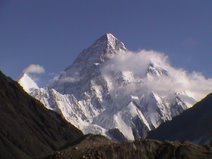

November 08, 1991
By
Dr. Syed Farooq Hasnat
A visit to the rural areas and small towns of northern and north western Iran is an exercise different from that of visiting big cities. The reports that appear in the western media and then picked up by the press of countries like Pakistan do not portrait the true state of development of the Iranian society. The assessments made in the foreign media judging Iran and its post war activities domestic as well as external, propagates a false impressions of a society which is on a bold advance with full vigour and strength to make up for the wasted years, both during the former Shah's reign and the eight years old imposed war by President Saddem Hussein. What is transmitted to the world is based on misinformation either consciously adopted or because of the lack of proper knowledge.
Yet another misconception originates from sporadic investigations carried on during a few days of a stay in a metropolitan city like Tehran. Expanding cities have their own peculiar characterises and does not always in a general term reflect on a national character.
Iran's twenty four provinces are demarcated on the basis of administrative convenience, therefore ethnic or linguist considerations become secondary in comprehending the country’s provincial profile. Nevertheless, the Kurdistan province of Iran has a concentration of Kurdish minority while the North Western province of Azerbijan inhabits the majority of Azeris a minority which speaks the Turkish language and belongs to the Iranians of the Azerbaijan stock.
A journey through the tract of Kirman Shah or renamed Bakhtaran province after the Islamic Revolution of 1979, with Bakhtaran, a beaming city with economic and social activity as its capital provides a unique experience both in terms of awareness about the Iranian society and the developmental schemes that are being enforced by the government for the uplift of the Iranian nation as a part of a full scale programme in the post war "decade of development".
The province comprises numerous small villages and towns, situated in the vast green valleys surrounded by high but barren mountains. It was in these harsh rocky mountains that legendary Farhad laboriously tried to dig a canal whose signs are visible even today – for his beloved.
The Kurd population of Bakhtaran province has been largely adjusted in the mainstream of the Farsi speaking community of Iran. Only those that live in the remote mountains or are nomads still maintain their separate identity and prefer to learn and speak only the Kurdish language. The necessity of looking for a livelihood in other regions of Iran have compelled most of the young Kurds to adopt the language and even the dress of the majority so as to easily adjust with the general population of the country. Many Iranians claim that Kurds are from the Iranian stock of race, and are therefore much closer to the Iranians in cultural terms than they are to any other race or ethnic community such as the Turks and the Arabs.
The lopsided economic development of the Shah era has been minimised and the prevalent practice is to plan with special considerations for the centuries old downtrodden communities residing in the remote areas far away from the capital. One should recognise that the real mettle of the Islamic revolution are the poor as well as the low middle class masses of Iran.
Throughout one’s journey in the rural Iran one detects a marked improvement in the agricultural districts along with the establishment of the supportive water resources. It is carried on the model of huge projects to constructs dams and other irrigational facilities for the farmers. The strongest component of the Iran society giving it an edge over the Persian Gulf region in its agricultural potential. That exactly is the field of development on which the revolutionary regime is concentrating the foremost. Iran remains the only country in the Persian Gulf region which has a great potential in agriculture not only for the domestic consumption but also for export.
The ignored rural Iran has in the post revolutionary era been granted an equal or even more share of the developmental piece regardless of its ethnic or geographical location. The impressions created by some critics that certain areas of Tehran are not receiving the attention that they used to during the Shah's time is true because the rich urban Iranian localities now have to share an equal ordeal with that of rural Iran. Rural Iran is getting its due recognition not only in agricultural sector but also petroleum as well as non petroleum industry is at the verge of a takeoff stage. The health /educational quarters are being given full attention wherever required.
The reconstruction work in the province of Bikhtaryan as well as Gilan and Mazdaran provinces (situated along the coast of the Caspian Sea in the North Central Iran ) captivates the attention of any visitor. The basis emphasis of the government has been on the reconstruction of either damaged projects or those that had been left incomplete because of the imposed war. These projects mostly fulfil prerequisite of a particular geographical area. For example the oil refinery near the city of Mazadaran that had been hit hard and repeatedly by the Iraqis has been restored to its full capacity. The gas extracted from the oil, burning over the top of the long chimney bears testimony to the fact stated. Other industrial projects are either under way or are planned for the near future.
The real strength of the Kurdish majority province Bakhtaran remains in the development of agriculture. There is abundance of water under the useable land in the area, there is machinery and know how and above all a will to develop the potentials of the land of this region. The shah's regime depended largely on the imports of the agriculture produce and its dependents and even such items like butter, milk and meat were imported from Holland, U.S., Australia, etc. for the privileged few. The sole dependency on oil and its products by the former regime lost the advantage that Iran always possessed in the region.
The northern provinces around the Caspian Sea, because of its rich land, are fairly advance in the agriculture sector. These provinces grow rice of a superior quality, grow a high quality tea as well as olives of notable worth. One can witness artificial forests being successfully grown on the otherwise barren mountains. It should be pointed out here that the Iranian mountains range constitutes of solid rock with very little mud formation which makes it difficult for the growth of easy vegetation.
The credit of the developmental projects in rural Iran goes especially to "Sazman i Jihad" (Jihad Organization), whose job is to start developmental projects where other sectors are hesitant to venture, either because of the difficult terrain or hardships confronted in terms of the nature of the task. This organization is directly under the control of the President.
The socio political structure of the rural Iranian society is the support base for the Islamic Iranian values as advocated by the Islamic Revolution. The rural population has been a supportive drive for the revolution thus making it possible for the system to secure roots in the country. After the war, the restrictions that accompany any emergency situation have been removed and the structures as well as code of laws are being adjusted as according to the requirements of the circumstances. The strong base of the Islamic Iranian culture is the masses of the rural Iran as well as the poorer sections of the big cities. A casual remark of the economically well off sections of the Iranian big cities is not a criteria to make a judgement.
The impression that one gets while visiting the small towns and villages of the Bakhtaran, Hamadan, Gilan and Mazadaran provinces is that the post war (1980 1988) Iranian society has more stability but also an equilibrium which the country badly needs in the complex and difficult regional as well as international political/military situation that it is placed. The Iranian people of the rural areas are much more confident of their abilities to move their societies towards economic and social development while keeping a secure proximity with its very strong Islamic Iranian cultural heritage.
The rural Iran, whether in the comparatively backward areas of the North west or elsewhere is now geared for the bold and enterprising policies for development and progress.




No comments:
Post a Comment